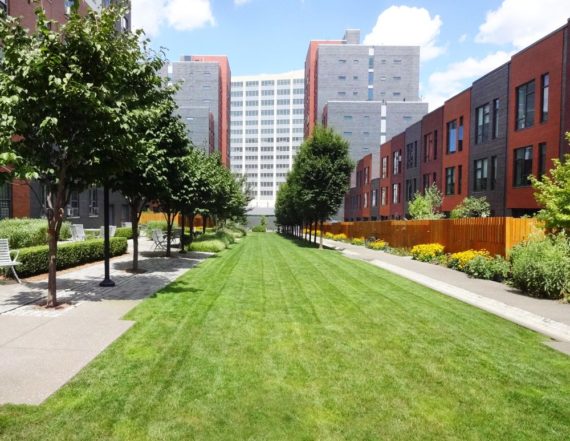
Navy Green’s common area where formerly homeless residents mingle with affluent neighbors
(6-7-19) How can we help individuals with serious mental illnesses who are chronically homeless, have co-occurring drug and alcohol problems and have been involved in our criminal justice system?
We’re often told such people are “treatment resistant.” A lost cause. Impossible to help.
That’s nonsense.
We have programs that work, we simply need more of them.
Yesterday found me in Brooklyn, New York, attending a board meeting of the Corporation for Supportive Housing, at one of the housing projects that we helped develop.
Navy Green, part of Brooklyn Community Housing and Services (BCHS), provides permanent supportive housing to 97 men and women who have Axis One diagnoses – people with schizophrenia, bipolar disorder and persistent and debilitating depression.
These are reportedly the most difficult to house and keep housed.
Yet, ninety-seven percent of individuals living in Navy Green in 2015 either maintained their housing or moved on to greater independence.
You read that right. A 97% yearly success rate. How?
Navy Green practices Housing First and provides robust services. It accepts tenants as they are and expects them to pay 30% of their income as rent. In return, residents are treated with respect and receive case management, access to a nurse, and a full array of recovery orientated programs.
Jeff Nemetsky, executive director of BCHS, explained that a major reason for Navy Green’s success is because it provides residents with social connectivity. A sense of belonging. Someone cares about you and you care about someone else.
A safe place to live, help that you need to recover, and a sense of community, rather than homelessness, no services and isolation.
But Pete, that must cost a fortune. We can’t afford that. Let’s look at the numbers.
According to Navy Green’s statistics, the daily cost per-person of hospitalization in Brooklyn is $1,422. The per-person cost in a psychiatric hospital is $560. Jail cost $197. A shelter runs $101 per night. So what are Navy Green’s per day cost per tenant? $45.
That’s right $45 per day.
We are in the midst of a growing homeless crisis.
The results of a Point In Time count, where workers go out on the streets of Los Angeles to see how many people are homeless, were released Tuesday. Los Angeles is the capital of homelessness in our country.
Last year’s count showed a decrease, but this year there was a 13% increase in overall homelessness with those experiencing homelessness for the first time accounting for a large portion of that increase.
- Los Angeles needs 516,946 more affordable rental homes to meet the current demand while the number of people currently experiencing homelessness is 59,000.
- 79% of Extremely Low Income households are paying more than half of their income on housing costs compared to just 3% of moderate income households.
- Renters in Los Angeles County need to earn $47.52 per hour – more than 3 times the local minimum wage – to afford the median monthly asking rent of $2,471.
One successful model that CSH promotes is mixing affordable housing with market driven housing. Navy Green’s building is connected to townhouses that sell for $2.5 million. Mr. Nemetsky explained that neighborhood residents were concerned when they first learned tenants with mental illnesses and substance abuse issues would be living next door. But there have been few incidents and now many younger, affluent Brooklynites view older Navy Green residents as substitute grandparents.
Navy Green’s tenants have been lifted up. If you are housed in a high crime area filled with homelessness and drugs, you will live like you are housed in a high crime area filled with homelessness and drugs. If you reside in a nice neighborhood, you will respond to that neighborhood’s standards.
Navy Green is an example of what can be.
The question for us and our leaders is why are we not funding more Navy Greens?



